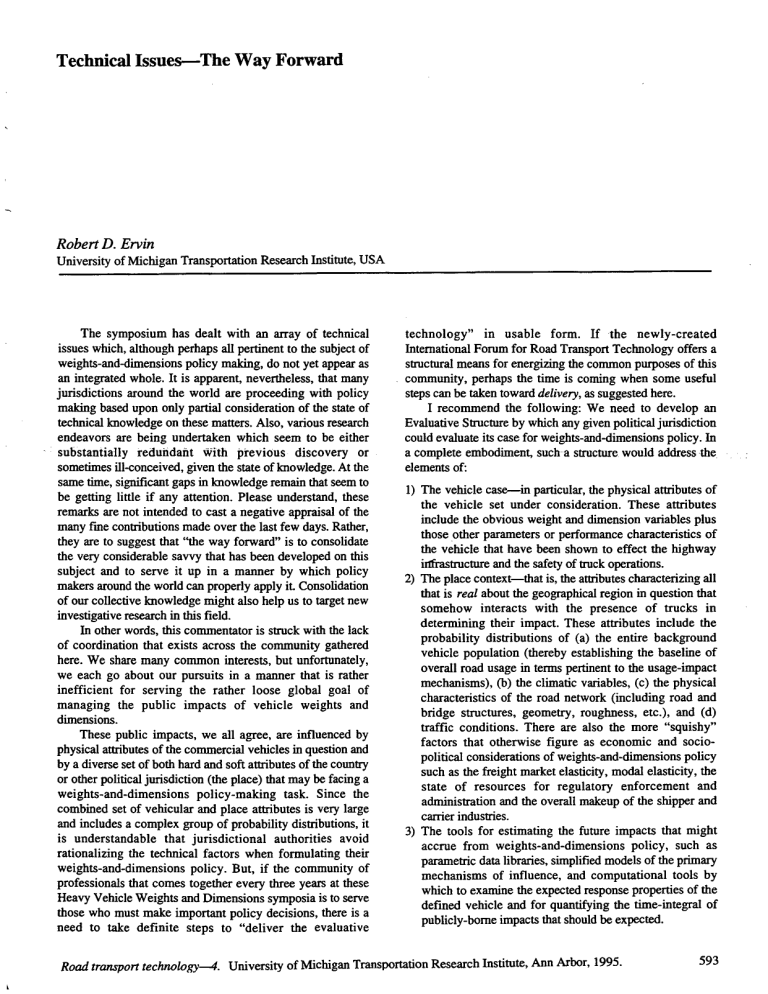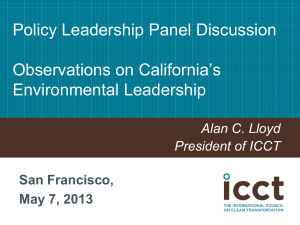Technical Issues-The Way Forward Robert D. Ervin

Technical Issues-The Way Forward
Robert D. Ervin
University of Michigan Transportation Research Institute, USA
The symposium has dealt with an array of technical iss~es which, although perhaps all pertinent to the subject of welghts-and-dimensions policy making, do not yet appear as whole. It is apparent, nevertheless, that many
Juns~lctlons around the world are proceeding with policy making based upon only partial consideration of the state of technical knowledge on these matters. Also, various research endeavors are being undertaken which seem to be either substantially redundant with previous discovery or sometimes ill-conceived, given the state of knowledge. At the same time, significant gaps in knowledge remain that seem to be getting little if any attention. Please understand, these remarks are not intended to cast a negative appraisal of the many fme contributions made over the last few days. Rather, they are to suggest that ''the way forward" is to consolidate the very considerable savvy that has been developed on this subject and to serve it up in a manner by which policy makers around the world can properly apply it Consolidation of our collective knowledge might also help us to target new investigative research in this field.
In other words, this commentator is struck with the lack of coordination that exists across the community gathered here. We share many common interests, but unfortunately, we each go about our pursuits in a manner that is rather inefficient for serving the rather loose global goal of managing the public impacts of vehicle weights and dimensions.
These public impacts, we all agree, are influenced by physical attributes of the commercial vehicles in question and by a diverse set of both hard and soft attributes of the country or other political jurisdiction (the place) that may be facing a weights-and-dimensions policy-making task. Since the com?ined set of vehicular and place attributes is very large
IS understandable that jurisdictional authorities avoid rationalizing the technical factors when formulating their weights-and-dimensions policy. But, if the community of professionals that comes together every three years at these
Heavy Vehicle Weights and Dimensions symposia is to serve those who must make important policy decisions, there is a need to take definite steps to "deliver the evaluative technology" in usable form.
International Forum for Road Transport Technology offers a structural means for energizing the common purposes of this community, perhaps the time is coming when some useful steps can be taken toward delivery, as suggested here.
I recommend the following: We need to develop an
Evaluative Structure by which any given political jurisdiction could evaluate its case for weights-and-dimensions policy. In a complete embodiment, such a structure would address the elements of:
If the newly-created irtfrastructure and the safety of truck operations.
2) The place context-that is, the attributes characterizing all that is real about the geographical region in question that publicly-borne impacts that should be expected.
Road transport technology-4. University of Michigan Transportation Research Institute, Ann Arbor, 1995.
.
1) The vehicle case-in particular, the physical attributes of the vehicle set under consideration. These attributes include the obvious weight and dimension variables plus those other parameters or performance characteristics of
~e vehicle that have been shown to effect the highway somehow interacts with the presence of trucks in determining their impact. These attributes include the probability distributions of (a) the entire background vehicle population (thereby establishing the baseline of overall road usage in terms pertinent to the usage-impact mechanisms), (b) the climatic variables, (c) the physical characteristics of the road network (including road and bridge structures, geometry, roughness, etc.), and (d) traffic conditions. There are also the more "squishy" factors that otherwise figure as economic and sociopolitical considerations of weights-and-dimensions policy such as the freight market elasticity, modal elasticity, the state of resources for regulatory enforcement and administration and the overall makeup of the shipper and carrier industries.
3) The tools for estimating the future impacts that might accrue from weights-and-dimensions policy, such as parametric data libraries, simplified models of the primary mechanisms of influence, and computational tools by which to examine the expected response properties of the defined vehicle and for quantifying the time-integral of
593
ROAD TRANSPORT TECHNOLOGY-4
4) A simplified protocol for cranking though the Evaluative
Structure and coming to a reasoned estimate of the public impacts of any given weights-and-dimensions policy.
The challenge is to evolve such an Evaluative Structure so as to enable at least the rational component of weightsand-dimensions decision making. (While other components, e.g., political, cultural, traditional, etc., will surely exist and may exercise great influence on the policy outcome, an increasingly pragmatic global economy may tend to press for concern of the rational part.) In service to the long term goal of supporting an Evaluative Structure, we the community of professionals engaged in the advancement of this field must cultivate a discipline that prioritizes those research endeavors which fill the gaps that exist in this Structure. That is, we must submit the research agenda in this field to the holy purpose of an Evaluative Structure that merits application as a more or less consensus method for approaching the task of weights-and-dimensions decision making. I suggest that we begin such an effort by preparing a candidate template for the
Evaluative Structure in time for the next symposium to be held in Australia in 1998. Another step that would promote fruitful research is to give a large cash award (say, $5000 to
$10,000) at each future symposium to the author(s) of that paper which helps most in realizing the Evaluative Structure.
594
(::r;;~?~C;~'¥3
.::
"~~v'J"
",fl
'> ....
~
'C' ;;
=-:,'.
&~
(f
---t,~t~ru
.
(1'.~:;'
"
',-
~"~"~ qo-~""~?'<, o o "
These proceedings are a cumulation of papers presented at the Fourth
Int~f1?ational
Symposium on Heavy Vehicle Weights and Dimensions. This series of symposia is a function ofthe International Forum for Road Transport Technology. An esse!1tialgoal of the Forum and of its symposia is the exchange of information between the various elements of the road transport community. We seek to bring together people involved in vehicle technologies and in infrastructure technologies, while at the same time attracting policy makers, administrators, road users, engineers, and,researchers.
The sixty-eight papers that 'make lip this book are divided into three major topic areas: policy, regulation, and economics; infrastructure technology; and vehicle technology.
Each of these areas is subdivided into a number of more specific topics. This book will be of interest to members of academia, industry.and government who are interested in the civil engineering and mechanical engineering aspects of roadway and heavy-vehicle technology, safety, and policy.
;;
",
0
0
.3
'::'~
" )
't·
0 ,
) 'c
) o
,)
"
C'
' p 0
Q
, g'
"" 0
,
,. o
0 0
THE
INTE~ATIONAL
FORUM FOR
ROAD TRANSPORT, TECHNOLOGY
Box 189, Carl&ton Rlace,
Ontano~
K7C 3P4, CANADA
President: Byron Lord
Federal Highway Administration, United states
Vice-President for Europe: John Aurell
VOlt~
Ttpck'Corporation, Sweden'
Vice-President for the' Pacific Rim: Peter Swealman'
"
Roaduser Research International, Australia o
0
Vice-President for
Deve~oping,
Countries: Joao Widmer
Uni~ersity ?f
Sao Paold:
Br~il'
' , . '
Secretary: John Woodrooffe
Roaduser Research International, Canada
Treasurer:
Christophe~
Mitchell
Transport Research Laboratory (retired), United Kingdom
Information Officer: David Cebon
University of Cambridge, United Kingdom
' 0
, ~
,
~
;:, ' . fl 0
Cover design,
py
Kathleen Richards. Cover photograph courtesy of Volvo GM Truck:~qrporation.
D,
University of Michigan Transportation Research Institute i
,
9 r ' ; / i
• o~





